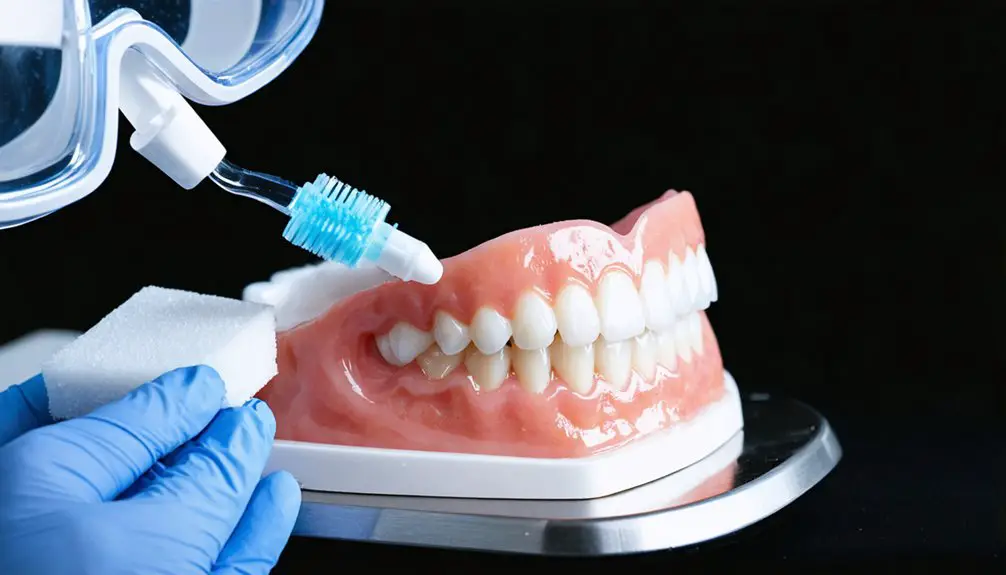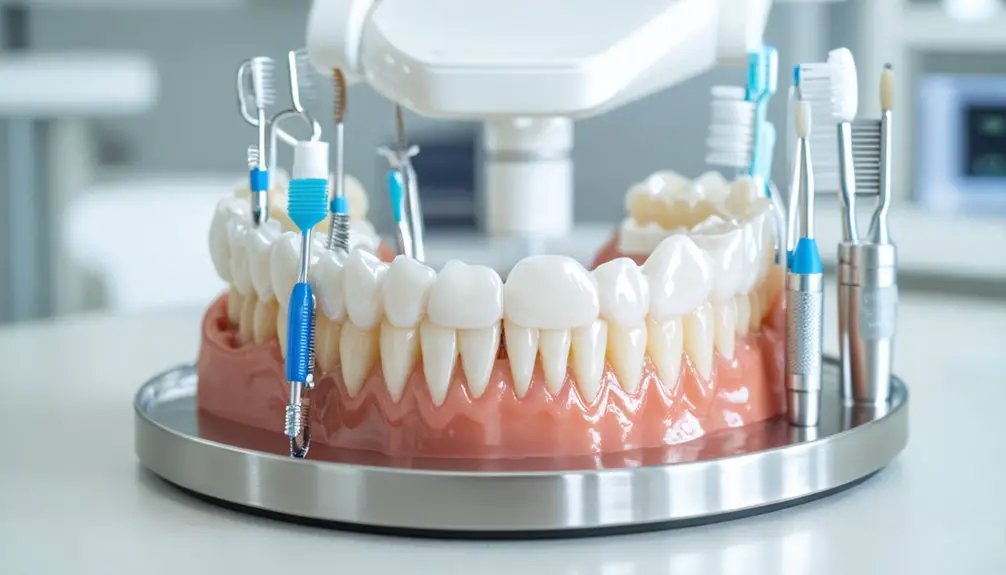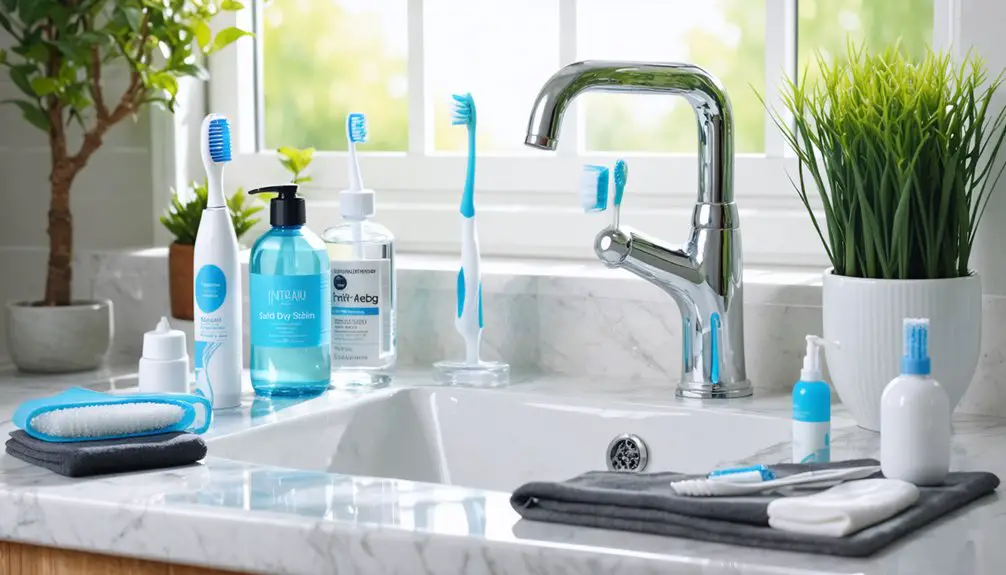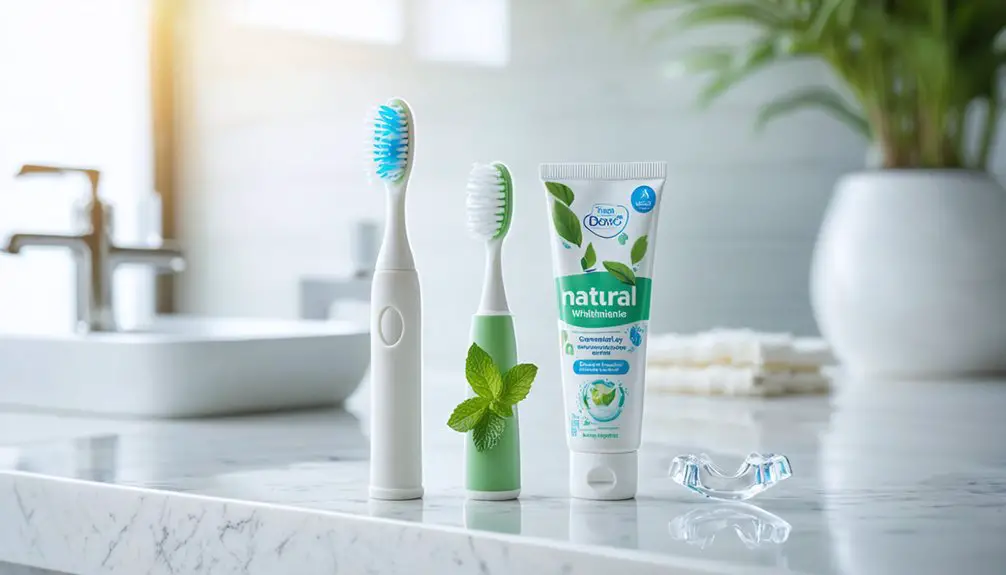To protect your gums during teeth whitening, start by having a dental professional apply a medical-grade barrier shield along your gum line. Next, choose whitening methods specifically designed for sensitive gums, like custom-fitted trays or lower-concentration gels that won’t overlap onto gum tissue. Finally, maintain proper aftercare by using desensitizing toothpaste and avoiding acidic foods. Understanding these professional techniques will enhance your whitening experience while safeguarding your oral health.
Key Takeaways
- Use professional-grade gum barriers during whitening treatments to create a protective shield between chemicals and sensitive gum tissue.
- Choose custom-fitted whitening trays that properly conform to your teeth, preventing gel from leaking onto gums.
- Apply whitening strips carefully, ensuring they don’t overlap onto gum tissue to avoid chemical contact and irritation.
- Use desensitizing toothpaste for two weeks before treatment to strengthen gum resistance and reduce sensitivity.
- Schedule a dental consultation before whitening to assess gum health and determine the most suitable treatment approach.
Professional Gum Barriers: Your First Line of Defense
When undergoing professional teeth whitening, gum barriers serve as an essential protective shield between your gingival tissue and powerful whitening agents.
These medical-grade, resin-based barriers prevent whitening chemicals from penetrating your sensitive gum tissue, considerably reducing the risk of burns and irritation.
Protect your delicate gums with resin barriers that block harsh whitening agents, ensuring a safe and comfortable smile-brightening experience.
Dental professionals require regular training sessions to maintain expert application techniques and stay current with safety protocols.
A thorough dental examination occurs before any barrier application to ensure your gums are healthy enough for the whitening procedure.
Your dental professional will carefully apply the barrier along your gum line using a precise gel syringe, ensuring complete gum protection while leaving tooth surfaces exposed.
After shaping the barrier to match your unique gum contours, they’ll use a specialized curing light to harden the material quickly.
This creates a durable shield that stays firmly in place throughout your whitening treatment.
With proper barrier application, you’ll experience enhanced comfort and achieve more uniform whitening results while maintaining ideal gum health.
Choosing the Right Whitening Method for Sensitive Gums
How you choose your teeth whitening method can greatly impact your gum health and comfort level during treatment. Before starting any at-home whitening regimen, schedule a sensitivity assessment with your dentist to determine the most suitable approach for your needs.
For sensitive gums, consider starting with lower-concentration carbamide peroxide products rather than hydrogen peroxide-based treatments. Active ingredients penetrate through the enamel layers to effectively remove deep stains. Custom-fitted trays offer precise application while minimizing gum contact, making them an excellent choice for those with sensitivity concerns. Professional treatment options can provide noticeable results in just one visit.
If you’re using whitening strips, make certain they don’t overlap onto your gum tissue.
Incorporate desensitizing toothpaste two weeks before beginning treatment, and monitor your progress carefully.
You’ll achieve better results by choosing gentle, gradual whitening methods that prioritize gum protection over rapid results.
Essential Pre and Post-Treatment Gum Care Steps
Proper preparation and aftercare greatly influence the success and safety of teeth whitening treatments. Before beginning, you’ll need a thorough pre-treatment cleaning to remove plaque and surface stains.
A thorough dental cleaning before whitening treatments removes buildup and surface stains, setting the foundation for optimal results and safety.
Schedule a consultation with your dentist to assess gum health and determine the most suitable whitening approach for your specific needs. The application of light-cured resin creates a protective shield that prevents burns and irritation during the whitening process.
Using a custom-fit tray helps minimize gel leakage onto sensitive gum tissue. To prevent gum irritation, make certain protective measures are in place, including the application of a resin-based gum barrier and proper fitting trays.
After treatment, monitor any sensitivity closely and maintain gentle oral hygiene practices. Use desensitizing toothpaste if needed, and avoid acidic foods that could aggravate your gums.
Remember to schedule follow-up appointments with your dentist to evaluate your gum health, and maintain proper hydration to support tissue healing.
Frequently Asked Questions
Can I Whiten My Teeth if I Have Receding Gums?
You’ll need professional evaluation before using whitening products since receding gums increase teeth sensitivity and damage risks. Only proceed with dentist-supervised treatments after your gum health improves through recommended treatments.
How Long Should I Wait Between Whitening Treatments to Protect My Gums?
Like giving your garden time to flourish, you’ll want to wait 6-12 months between professional whitening treatments and 3-6 months between at-home applications to maintain ideal gum health and prevent sensitivity.
Will Gum Grafts Affect My Ability to Get Teeth Whitening Treatments?
You’ll need to wait 4-8 weeks after gum grafting before whitening. Once healed, you can safely whiten your teeth, but you’ll need your dentist’s approval and professional monitoring during treatment.
Does Smoking Impact Gum Sensitivity During Teeth Whitening Procedures?
Want a double whammy of discomfort? Your smoking habit will greatly intensify gum sensitivity during whitening treatments. Smoking’s detrimental effects on gum health make your tissue more vulnerable to irritation and inflammation.
Can I Use Natural Whitening Methods if I Have Existing Gum Problems?
You’ll need to exercise caution with home remedies if you have gum problems. Focus on gentle options like oil pulling, avoid acidic treatments, and consult your dentist before starting any whitening routine.
References
- https://www.hdasmiles.com/post/gum-protection-during-whitening-what-to-expect-at-your-appointment/
- https://www.laserglowspa.com/products/gingival-barrier-gum-protector-gel
- https://www.sandiegoartofdentistry.com/blog/what-is-the-best-teeth-whitening-method/
- https://valleycreekdentalcare.com/blog/preventing-gum-irritation-teeth-whitening-expert-tips-for-a-safe-experience
- https://pmc.ncbi.nlm.nih.gov/articles/PMC4058574/
- https://www.laserglowspa.com/blogs/news/gingival-barrier-why-you-need-protection-during-teeth-whitening
- https://medidenta.com/product/whiter-image-gingival-barrier/
- https://www.hfdentalcare.com/blog/your-step-by-step-guide-to-teeth-whitening-at-the-dentist/
- https://www.blvddentistry.com/can-you-get-whitening-treatment-with-sensitive-teeth/
- https://supremiadentistry.com/the-5-best-ways-to-whiten-sensitive-teeth/



